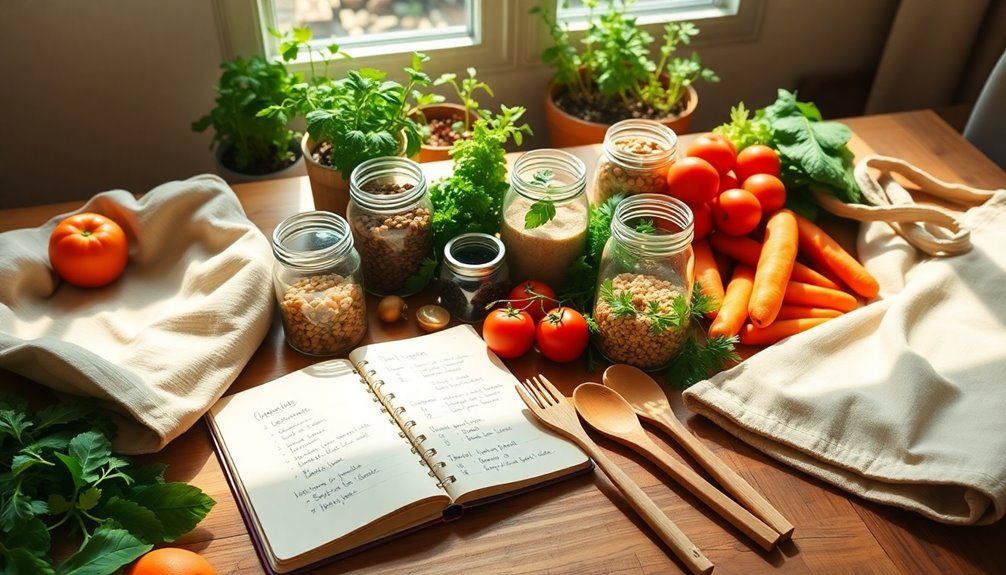To maximize sustainability in your meal planning, start by choosing local, seasonal ingredients. This not only supports local farmers but also reduces your carbon footprint from transportation. Incorporate more plant-based meals, as they require fewer resources and promote health benefits. Aim to minimize food waste by planning meals that use up ingredients effectively and creatively utilizing leftovers. Smart shopping with a list will help you avoid impulse purchases and unnecessary waste. Finally, learn effective food storage methods to keep your ingredients fresh longer. These steps lay the groundwork for sustainable eating, and you'll uncover more strategies to enhance your efforts.
Key Takeaways
- Prioritize local and seasonal ingredients to reduce transportation emissions and support local farmers.
- Plan meals around what's in your pantry to minimize food waste and use existing ingredients creatively.
- Incorporate balanced, plant-based meals to enhance resource efficiency and provide health benefits.
- Create a shopping list based on your meal plan to avoid impulse purchases and reduce waste.
- Store food properly to extend its freshness and ensure leftovers are used effectively.
Understand Sustainable Eating
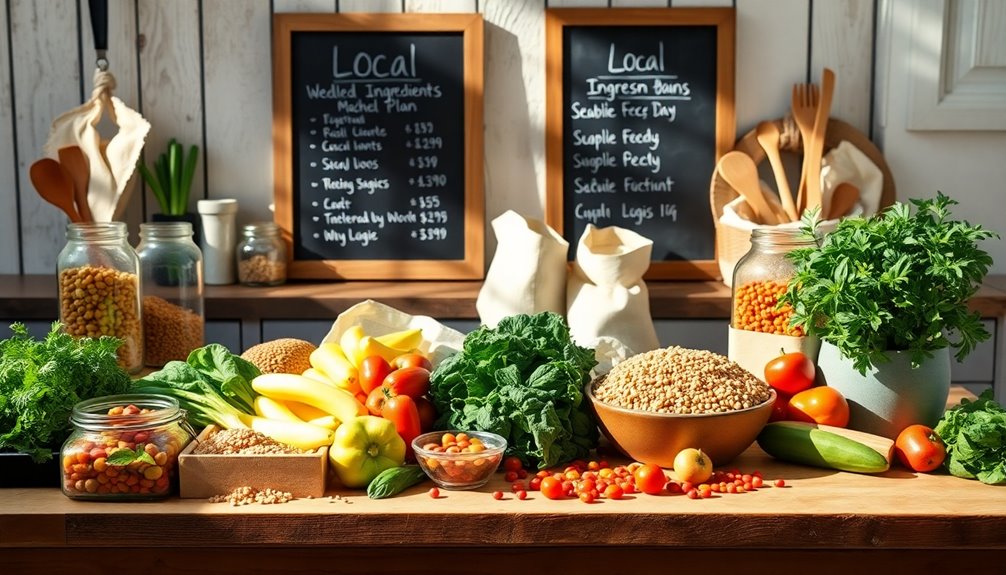
Understanding sustainable eating is essential for making choices that benefit both your health and the planet. When you choose to eat sustainably, you're not just filling your plate; you're also contemplating the ethical sourcing of your food. This means selecting ingredients that come from farms and producers who prioritize environmental care and fair labor practices. By doing so, you're actively reducing the environmental impact of your meals, contributing to a healthier ecosystem.
Sustainable eating isn't just an abstract concept; it has tangible health benefits too. Foods that are grown responsibly tend to be fresher and richer in nutrients, which can enhance your overall well-being. Opting for organic or locally sourced products often means you're consuming fewer harmful chemicals, which is a win for both your body and the environment. Additionally, embracing a plant-based diet can significantly reduce your carbon footprint and promote sustainability.
Moreover, when you support local farmers and producers, you strengthen community bonds. Your choices help foster a sense of belonging as you engage with those who cultivate the food you eat. This community support creates a ripple effect, encouraging others to contemplate the impact of their dietary choices.
Embracing sustainable eating allows you to align your values with your actions. It's about making informed decisions that resonate with your desire to contribute positively to both your health and the world around you. By understanding these principles, you empower yourself to make choices that matter, creating a more sustainable future for everyone.
Choose Seasonal Ingredients
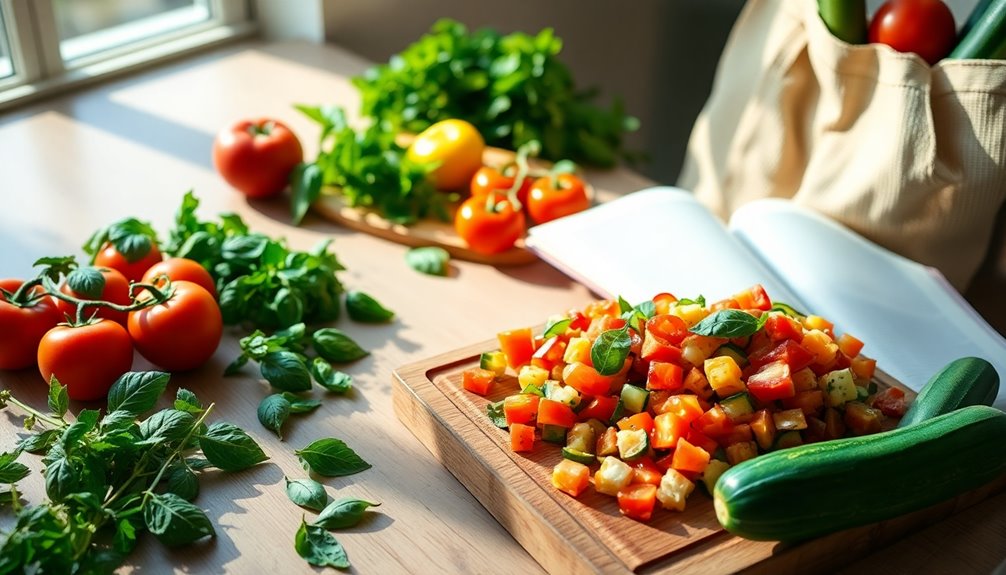
Choosing seasonal ingredients is a key strategy in sustainable eating that can significantly reduce your ecological footprint while enhancing the flavors of your meals. When you opt for seasonal produce, you're not just savoring fresh flavors; you're also supporting local farmers and reducing the carbon emissions associated with transporting food long distances.
One great way to access seasonal ingredients is through farmers markets and community supported agriculture (CSA) programs. These avenues connect you directly with the producers, letting you enjoy the freshest options while fostering a sense of community.
Here's a simple breakdown of seasonal produce based on the seasons:
| Season | Examples of Seasonal Ingredients |
|---|---|
| Spring | Asparagus, Spinach, Strawberries |
| Summer | Tomatoes, Zucchini, Peaches |
| Fall | Pumpkins, Apples, Brussels Sprouts |
| Winter | Kale, Squash, Citrus Fruits |
Incorporating seasonal ingredients can also help align with natural calorie cycles, promoting a healthier and more sustainable dietary approach.
Prioritize Local Produce
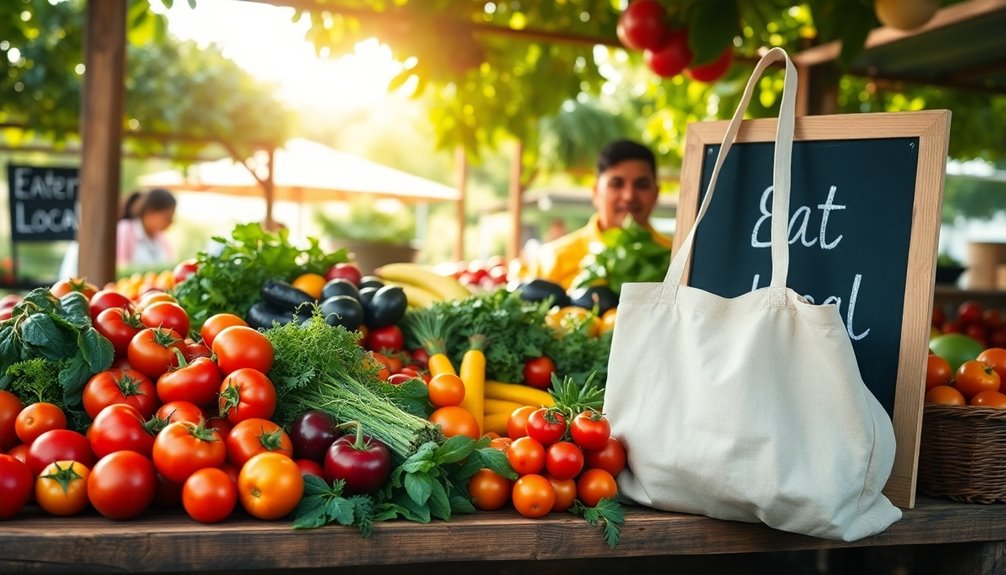
Supporting local produce is a powerful way to enhance your meals while promoting sustainability. When you choose to buy from local farmers, you're not just filling your plate with fresher, tastier ingredients; you're also making a significant impact on your community and the environment. By prioritizing local produce, you directly support farmers who work hard to cultivate their crops, often using sustainable practices that benefit the land.
One of the most compelling reasons to go local is the reduction in emissions associated with transporting food. When you purchase produce that's grown nearby, you cut down on the carbon footprint linked to long-distance transportation. This means less fuel consumption and fewer greenhouse gases released into the atmosphere. In this way, your choices at the grocery store or farmer's market contribute to a healthier planet.
Moreover, local produce often comes with the added bonus of being in season, which means it's not just fresher but also more nutrient-dense. Eating in alignment with what's grown around you fosters a deeper connection to your environment and encourages a sense of belonging within your community. You're not just a consumer; you're part of a network that values sustainability and supports local economies.
Incorporating local ingredients into your meals can transform your cooking experience, making it more vibrant and meaningful. Additionally, supporting local farmers can lead to better health outcomes, as studies have shown that sustainable practices can positively impact the nutritional quality of food. So next time you plan your grocery list, consider how you can prioritize local produce and enjoy the benefits that come with it.
Reduce Food Waste
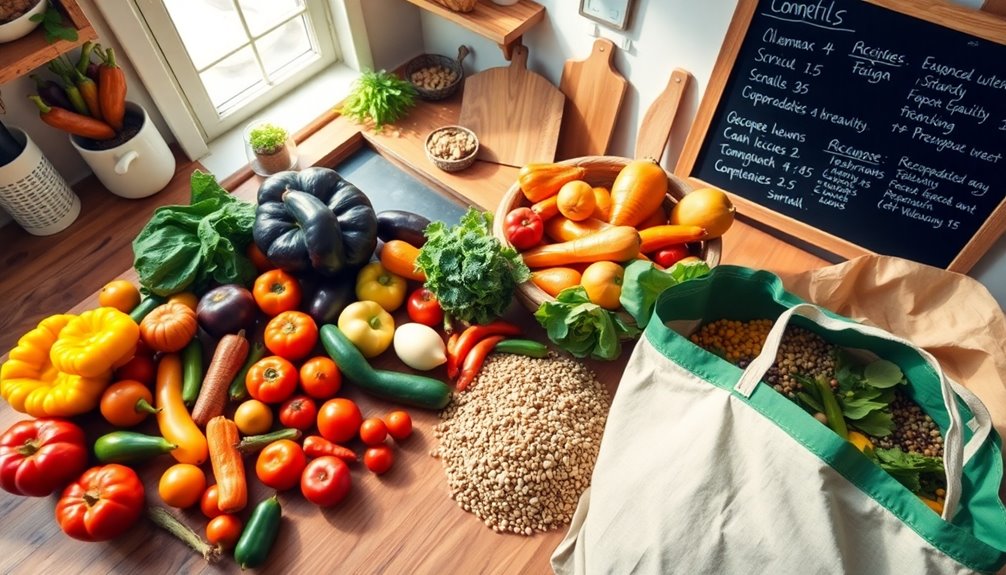
While prioritizing local produce is a great step toward sustainable eating, reducing food waste is equally important in creating a more environmentally friendly kitchen. By minimizing waste, you not only save money but also contribute to a healthier planet. Here are some practical strategies to help you reduce food waste effectively:
- Plan Your Meals: Meal prep isn't just about convenience; it's a powerful tool for reducing waste. When you plan your meals, you'll buy only what you need, preventing impulse purchases that often lead to excess.
- Store Food Properly: Make sure you're storing your food in ways that keep it fresh longer. Use airtight containers, and keep your fridge organized to avoid forgotten items.
- Use Leftovers Creatively: Don't let leftovers go to waste. You can transform them into new dishes, like soups or stir-fries. And if something's past its prime, compost leftovers instead of tossing them.
- Share with Friends: If you have extra food, consider sharing with friends or neighbors. Not only does this reduce waste, but it also fosters community connections.
- Understand Expiration Dates: Know the difference between "sell by," "use by," and "best before" dates. Many foods are still safe to consume after these dates. Additionally, incorporating healthy recipes and meal ideas can help you use ingredients efficiently and minimize waste.
Here's a quick summary of tips to reduce food waste:
| Tip | Action |
|---|---|
| Plan Your Meals | Create a weekly meal prep plan |
| Store Food Properly | Use airtight containers |
| Get Creative with Leftovers | Turn leftovers into new dishes |
| Share with Friends | Offer extra food to neighbors |
| Understand Expiration Dates | Learn the meanings of labels
Plan Balanced Meals
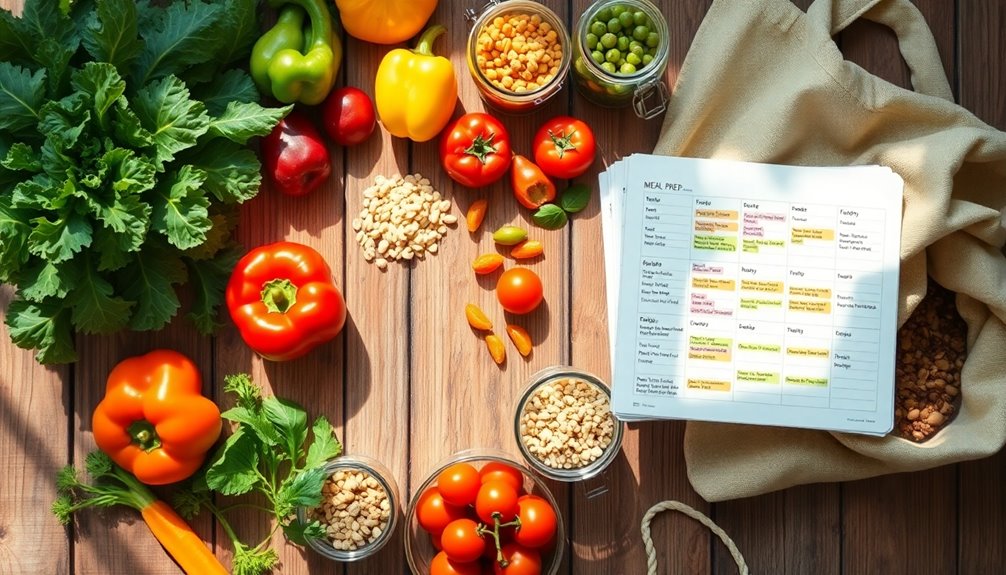
Creating balanced meals is crucial for maintaining a healthy lifestyle and supporting sustainability goals. When you plan your meals thoughtfully, you not only nourish your body but also reduce your environmental impact. Here are some key strategies to help you achieve balanced meals:
- Prioritize Whole Foods: Choose fresh fruits, vegetables, whole grains, and lean proteins to provide essential nutrients.
- Practice Portion Control: Be mindful of serving sizes to avoid overeating and minimize food waste. This guarantees you're not only satisfied but also using your resources wisely.
- Incorporate Variety: Include a mix of food groups in each meal. This not only keeps your meals interesting but also guarantees you're getting a broad spectrum of nutrients.
- Plan Ahead with Meal Prep: Set aside time each week to prepare meals in advance. This can help you avoid unhealthy last-minute choices and make certain you're using up all the ingredients you buy.
- Use Seasonal Ingredients: Opt for locally-sourced, seasonal produce. It's fresher, tastes better, and has a smaller carbon footprint.
Additionally, adopting a plant-based diet can significantly reduce your environmental impact while enhancing your overall health.
Explore Plant-Based Options

Exploring plant-based options enhances your meals and also contributes significantly to sustainability efforts. By incorporating more fruits, vegetables, legumes, and whole grains into your diet, you're not just making a personal choice; you're also making a positive environmental impact. Plant-based foods typically require fewer resources—like water and land—than animal-based products, making them a sustainable choice for anyone looking to reduce their carbon footprint.
The nutritional benefits of a plant-based diet are well-documented. You'll find that these foods are often rich in vitamins, minerals, fiber, and antioxidants, which can improve your overall health. Plus, they can be incredibly flavorful! Try experimenting with different cooking techniques, such as roasting, grilling, or sautéing, to bring out the natural tastes of ingredients.
You might also enjoy flavorful recipes that highlight the versatility of plant-based cuisine. For instance, consider a hearty lentil stew, packed with spices and fresh vegetables, or a vibrant quinoa salad bursting with colors and textures. These meals not only satisfy your taste buds but also showcase how delicious plant-based eating can be. Additionally, incorporating protein-packed vegan smoothies into your diet can provide essential amino acids for muscle synthesis while keeping your meals enjoyable.
Incorporating more plant-based options into your meal planning fosters a sense of community. Whether you're sharing recipes with friends or hosting a gathering with plant-forward dishes, you create an inclusive atmosphere that encourages others to join you on this sustainable journey. Embrace these options, and relish the benefits they bring to your health and the planet.
Practice Smart Shopping
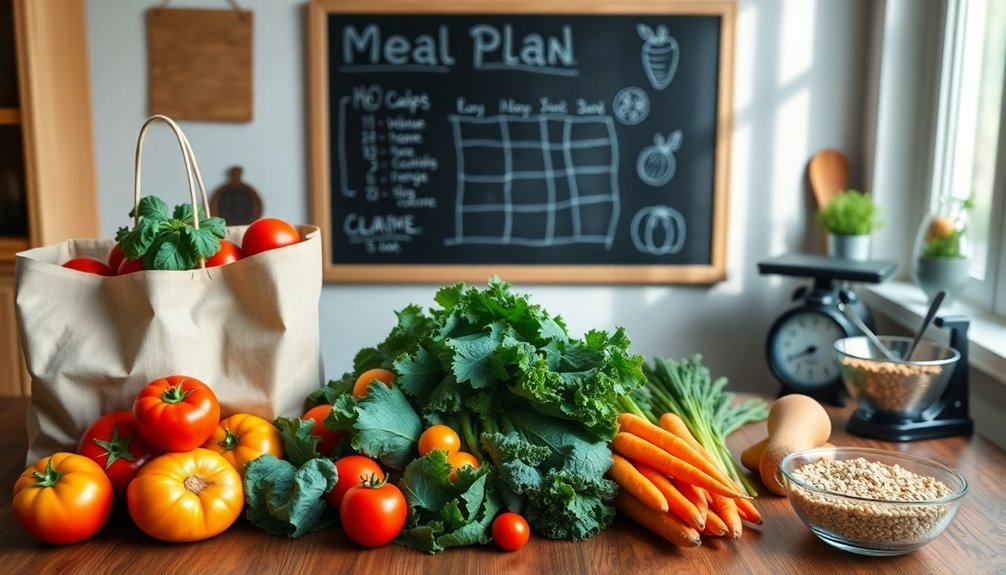
Smart shopping can greatly impact both your health and the environment. By being intentional about your grocery choices, you can support sustainable practices while still sticking to your budget. This doesn't have to be complicated; it's about making informed decisions that align with your values. Here are some tips to help you practice smart shopping:
- Plan your meals: Take time to create a meal prep plan for the week. Knowing what you'll cook reduces impulse buys and food waste.
- Buy seasonal produce: Seasonal fruits and vegetables are fresher, tastier, and often cheaper, supporting local farmers and reducing transportation emissions.
- Choose bulk items: Budget shopping often means purchasing in bulk. Buy grains, nuts, and legumes in larger quantities to save money and reduce packaging waste.
- Opt for local products: Whenever possible, seek out local and organic products. They're usually more sustainable and can foster a sense of community.
- Use a shopping list: Stick to a list that aligns with your meal prep. This helps you avoid unnecessary purchases and keeps your spending in check.
Additionally, being mindful of your dietary choices can contribute to better liver health, as fatty liver occurs when liver fat content exceeds 5%, which can be influenced by modern diets high in processed foods.
Store Food Effectively
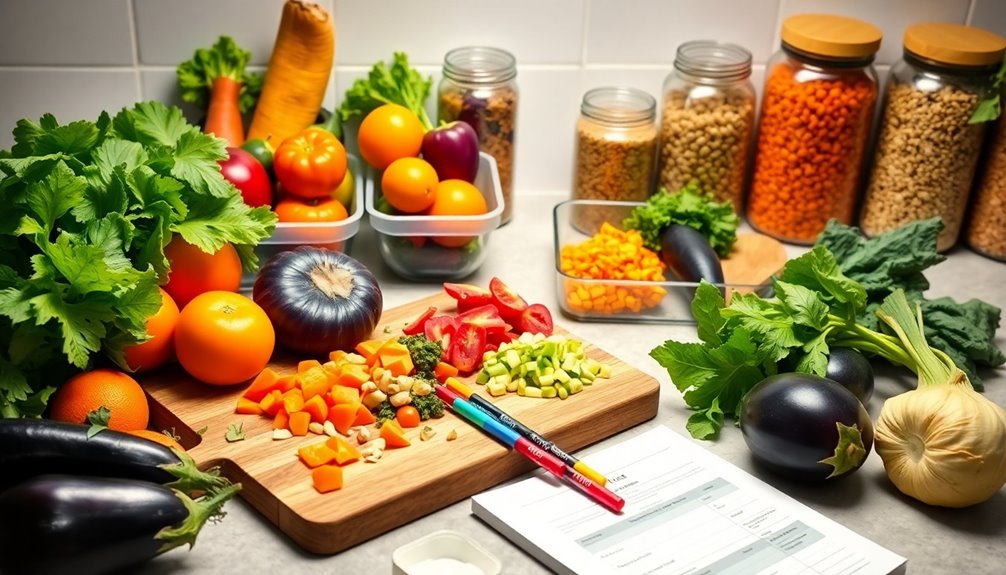
Effective food storage is essential for reducing waste and maximizing the freshness of your ingredients. By organizing your pantry and utilizing eco-friendly packaging, you can create a sustainable kitchen environment that benefits both you and the planet. It's all about using proper storage techniques and investing in reusable containers to keep your food fresh. Additionally, hand sharpening your kitchen tools can enhance your cooking experience by ensuring precision in food preparation.
Here's a quick reference table to help you understand the best storage methods for various foods:
| Food Type | Best Storage Method | Ideal Container |
|---|---|---|
| Fruits | Cool, dry place | Breathable eco-friendly bags |
| Vegetables | Refrigerate in crisper drawer | Reusable glass containers |
| Grains & Pasta | Airtight, dry location | Reusable plastic or glass jars |
| Leftovers | Refrigerate & consume quickly | BPA-free food storage containers |
When you practice proper storage, you'll not only prolong the life of your food but also enhance your pantry organization. Using reusable containers reduces single-use plastic waste, aligning with sustainable values. Take a moment to assess your current storage habits. Are you utilizing eco-friendly packaging? If not, consider making the switch to environmentally responsible options.
Frequently Asked Questions
How Does Meal Planning Impact Environmental Sustainability Long-Term?
Meal planning greatly impacts environmental sustainability in the long run. By organizing your meals, you reduce waste, ensuring you use ingredients before they spoil. This waste reduction not only minimizes landfill contributions but also conserves resources, from water to energy, that go into food production.
When you make thoughtful choices about what to cook and eat, you foster a more sustainable lifestyle, encouraging others to join in and create a collective positive impact.
What Are the Benefits of Meal Prepping for Sustainability?
When it comes to meal prepping for sustainability, you're hitting two birds with one stone. By planning ahead, you reduce waste since you'll only buy what you need, preventing food from going bad.
Plus, you save money on groceries by avoiding impulse purchases. This not only helps your wallet but also fosters a sense of community by encouraging shared meals and reducing the environmental impact.
It's a win-win for you and the planet!
Can I Incorporate Leftovers Into My Meal Plan Effectively?
You can definitely incorporate leftovers into your meal plan effectively! By utilizing leftover ingredients, you're not just cutting down on waste; you're enhancing your meal prep.
Think about how you can repurpose last night's dinner into a delicious lunch or a new dish. Sustainable ingredient sourcing also plays a role here—choose quality items to [guarantee] your meals are both nutritious and flavorful.
This approach fosters a sense of community as you share creative recipes with others.
How Do Food Choices Influence Carbon Footprints?
Your food choices greatly influence your carbon footprint. For instance, food transportation contributes to greenhouse gas emissions; choosing locally sourced ingredients can reduce this impact.
Additionally, opting for seasonal produce not only supports local farmers but also minimizes the energy used in growing and transporting out-of-season items.
What Role Do Cooking Methods Play in Sustainable Eating?
When you cook, it's like orchestrating a symphony of flavors and methods. Your cooking methods play an essential role in sustainable eating by reducing waste and boosting energy efficiency.
Opting for techniques like steaming or stir-frying can use less energy compared to boiling or baking. Plus, using leftovers creatively not only minimizes waste but also enhances your meals.
Conclusion
In the garden of sustainability, every meal you plan acts as a seed for a healthier planet. By choosing seasonal and local ingredients, you're cultivating a future where food waste withers away, and balanced meals flourish. Embracing plant-based options is like nurturing a diverse ecosystem, while smart shopping and effective storage are the sunlight and water that help your efforts thrive. As you dig deeper into sustainable eating, you're not just feeding yourself; you're sowing the seeds of change.

